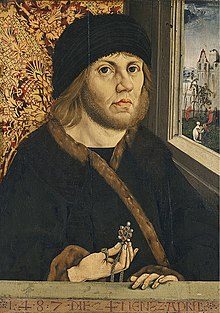Wolfgang Beurer
Master WB , probably Wolfgang Beurer , was a painter, draftsman and engraver who worked in Germany on the Middle Rhine between 1480 and 1500 . He was probably trained in Nuremberg in the workshop of Hans Pleydenwurff or his workshop successor Michael Wolgemut . He is known for particularly unusual color and light effects in the backgrounds of his landscapes.
A series of panel paintings with scenes from the Sebastian legend are attributed to Beurer , today in the Cathedral and Diocesan Museum (Mainz) . With this main work and his copperplate engravings and drawings, he is considered to be one of the more important painters from the late Gothic period working on the Middle Rhine. His appreciation in the art of his time is underlined by the fact that Albrecht Dürer met him on his trip to the Rhineland in 1491/1492 and used a drawing by the master that he then came into possession as a suggestion and template in his own works.
Name identification
A series of drawings and copperplate engravings with the monogram “WB” around 1490/1500 (today e.g. in the Hamburger Kunsthalle or in the National Museum Gdańsk) are assigned to the master WB . Underneath there is a sheet that bears the note that Albrecht Dürer can prove: “Dz hat Wolfgang pewrer made / Im 1484 Ior”. As a result, the master WB was identified in modern name reading as Wolfgang Beurer (or Peurer). Stylistic comparisons then assigned him the pictures of the works carried under the emergency name Master of the Mainz legend of Sebastian . Wolfgang Beurer is classified by the history of art in the works assigned to the house book master, sometimes even equated with one of the artists working in the house book. However, the identification with the main master of the house book remains controversial. Dürer also knew an Anton Beurer, of whom he also wrote on a drawing sheet.
Works
- Eight scenes from the Sebastian legend, Mainz Cathedral Museum The Sebastian legend may have been displayed for a short time in the Sebastian Church in Oppenheim near Worms.
- Portrait counterparts: Portrait of a Man, 1495 - 1500, and Portrait of a Woman, 1495 - 1500 (Städelsches Kunstinstitut lnv. No. 334 and 335)
- Portrait of a Man (dated 1487) (Madrid, Thyssen-Bornemisza Museum)
- Book of Hours Egerton Ms. 1146 (around 1475 - 1485). There he is mainly attributed the calendar part with its unusual color effects.
literature
- Bodo Brinkmann: An unknown work by Wolfgang Beurer, the master WB . In: Städel-Jahrbuch 15 (1995), pp. 145–174.
- Ernst Buchner: Studies on Middle Rhine painting and graphics of the late Gothic and Renaissance. I. The master WB . In: Munich Yearbook of Fine Arts NF 4 (1927), pp. 229–275.
Web links
Two portraits in the Städel Museum
Individual evidence
- ↑ Wolfgang Beurer, Master WB. In: General Artists Dictionary, International Artists Database, KG Saur Verlag,. Accessed online February 2010
- ^ Dommuseum Mainz: Eight panels with scenes from the life of St. Sebastian (picture description). Accessed online February 2010
- ↑ cf. for name identification and catalog raisonné Fedja Anzelewsky : A group of painters and draftsmen from Dürer's youth . In: Yearbook of the Berlin Museums, NF 27.1985, pp. 35–59
- ^ V. Michael Strocka: Albrecht Dürer and Wolfgang Peurer . In: M. Gosebruch and L. Dittmann (eds.): Argo: Festschrift for Kurt Badt DuMont Schauberg, Cologne: 1970, pp. 249–260
- ↑ so also Hutchison
- ↑ Fedja Anzelewsky: A group of painters and draftsmen from Dürer's youth . In: Yearbook of the Berlin Museums, NF 27.1985, pp. 35–59
- ^ B. Brinkmann: An unknown work by Wolfgang Beurer, the master WB . In: Städel-Jahrbuch 15/1995, pp. 145–174
- ↑ Eight panels with scenes from the life of Saint Sebastian ( Memento from April 12, 2012 in the Internet Archive )
- ↑ cf. also W. Wilhelmy: Oppenheim, Worms and the master WB: New research on the Mainz legend of Sebastian . In: Mainzer Zeitschrift Vol. 96/07 (2001–2002) pp. 55–64
- ↑ Brinkmann 1995.
| personal data | |
|---|---|
| SURNAME | Beurer, Wolfgang |
| ALTERNATIVE NAMES | Master WB |
| BRIEF DESCRIPTION | Old German painter, draftsman and engraver |
| DATE OF BIRTH | 15th century |
| DATE OF DEATH | 15th century or 16th century |
